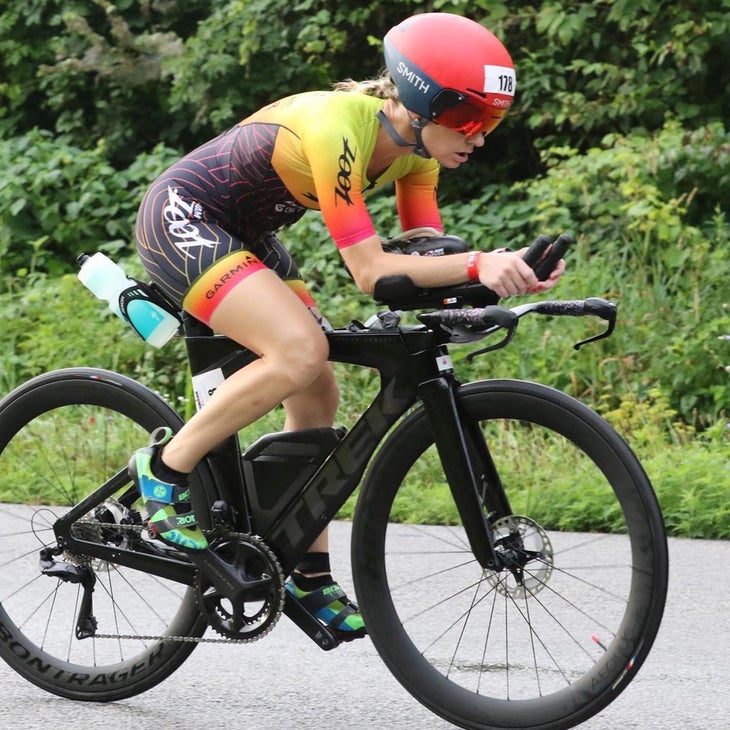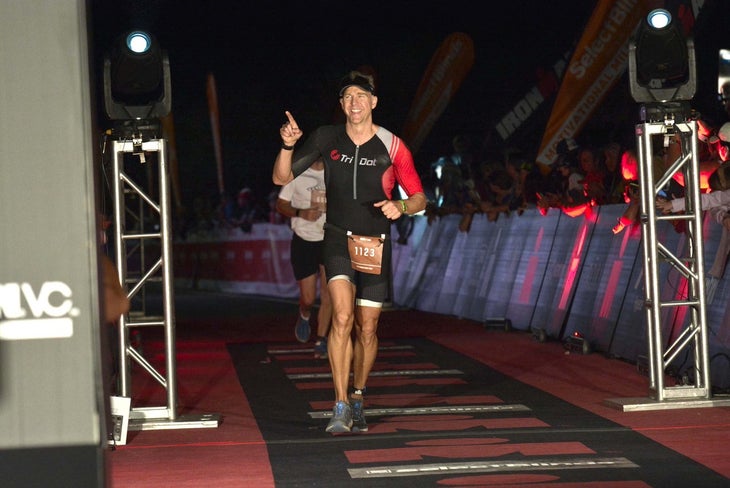When Lauren Leblanc eased back into triathlon training in 2020, it had been seven years and two kids since she’d last raced. She was 38, and her earlier athletic career had been plagued with injuries. Needless to say, her expectations were pretty low. But she needed a new goal, so she signed up for a small, Olympic-distance triathlon near her Michigan hometown in September of that year. It went OK, so she signed up for another: the Steelhead 70.3 in 2021.
Steelhead was a bucket-list race for Leblanc; her only goal was to finish. But a few hours after the race, she wandered over to the awards ceremony and felt her jaw drop: she’d finished 11th in her age group—and qualified for 70.3 Worlds.
That season—her first back on the circuit in the better part of a decade—Leblanc earned USAT All-American and IRONMAN Gold All-World Athlete status. Before 2020, she would have told you those titles were never within the realm of possibility. So what changed?
A few things. For one, Leblanc had seriously committed to structured training for the first time. She used TriDot, which analyzed her training data and biometric information to create and update custom workouts in real time.
The other big change had to do with Leblanc’s perspective on off-season training.
Previously, Leblanc thought of the winter months the same way almost everyone else does: as a literal off-season. But in 2020 she started thinking differently. What if instead of running and biking haphazardly during the winter, or just accumulating huge amounts of “base miles,” she was intentional and structured with her winter training? Would she end up better prepared for the season? Or burned out or injured?

Jeff Booher, a triathlete, coach, and the founder and CEO of TriDot, had been asking himself that same question. He’d read a lot of conflicting information from various top coaches and was hungry for real answers—answers that were based not just on training philosophy but on science and actual results. So, in 2011, he organized and launched a unique, multiyear study.
Now known as the Preseason Project, the study uses TriDot’s algorithm to analyze the training habits and results of Olympic-, Half Ironman–, and Full Ironman–distance athletes. In exchange for sharing their training data, participating athletes get two free months of TriDot’s optimized training programs and supportive online community.
Big Data, Big Gains
Currently in its 12th year, the Preseason Project has another purpose too. TriDot’s algorithm is run by powerful artificial intelligence technologies, including machine learning. The program’s effectiveness gets better as its database grows. By welcoming new athletes at the beginning of every season, TriDot is able to further refine its training prescriptions and make its athletes faster. And in return, numerous athletes get accessible (read: free) training that’s tailored to their specific needs.
“That’s part of what attracted me to TriDot,” explains Chad Rolfs, an Ironman athlete and triathlon coach. “I love to be a part of something bigger than myself and feel like I’m able to share what I’ve learned and experienced.” As a coach, he liked the idea that his data would help make the program more powerful and more effective for athletes everywhere. So, like Leblanc, he participated in the Preseason Project during his first year on TriDot.
As for the actual benefit of all that preseason training, after more than a decade of research the results are pretty impressive.
“What we found was that the athletes who did both in-season and preseason training with TriDot saw twice as much improvement as those who came into TriDot only for the in-season,” explains Matt Bach, TriDot’s VP of marketing. In other words, tacking on a couple of extra months of intentional training to the schedule doubled the value of athletes’ training.
As for those who signed up for TriDot but didn’t use its training tools at all, this group, which served as the experiment’s control group, also improved over the course of the season—but only by a little over a minute.
Pretty striking, but how does it all work?
“Well, the thing about the preseason,” Booher explains, “is that those are the months where an athlete actually has a chance to raise their threshold capacity and overall fitness. In the three or so months right before a race, you’re primarily only extending your stamina, but it’s nearly impossible to also improve your fitness ceiling—by then, it’s too late.”
“The benefits you gain in the four or five months before in-season are at least as important as those last few months leading up to your race,” Booher says.
Training for Life
For Leblanc, that was definitely the case. Since she began extending her training into the winter months, she’s seen massive improvements—not just in her race times but in her overall fitness.
“I wouldn’t believe it if it didn’t happen,” she says. “When I first started [the Preseason Project] my bike threshold was 1.4 or 1.6 watts per kilogram and now it’s 3.9. My best 5K was 23 minutes before, and I went 19:17 this spring.” (That’s all without any injuries, by the way—a stunning departure from her pre-TriDot days.)

Leblanc also emphasizes that she’s not doing anything beyond what the program’s telling her to do. After all, she’s a full-time physician’s assistant with two little kids. She already does most of her workouts indoors, armed with snacks and other kid-distractions on her stationary bike or treadmill. When would she even have time to do extra workouts?
“That’s the magic of TriDot,” Booher explains. “It gives you exactly what you need and nothing else. Not only is the platform equipped with tons of information about each athlete—from your genetic profile and injury-proneness to your age and aerobic potential—but it also normalizes its recommendations to exactly suit the elevation and weather conditions where you’re training.”
That’s the kind of information coaches and athletes don’t usually have, let alone know how to process.
“Without TriDot, a coach doesn’t know if it was warmer than usual on the day you did your last run,” Booher explains. “They’re just going to look at your splits and say, ‘Oh, you blew up on that last workout, we need to dial it back,’ but really you don’t. It was just hot that day.” In this example, the athlete didn’t realize it was unseasonably warm—and trying to hit a normal split under those conditions could have resulted in injury. Conversely, if the coach then dials back those targets unnecessarily, she could unwittingly hamstring that same athlete’s progress.
TriDot handles all those measurements automatically, adjusting its targets according to the location, humidity, temperature, and time of day. And it encourages athletes to stick to those targets by awarding them a TrainX score for each workout. Go too hard, and your score suffers. Ditto if you come in under your targets.
“If you’re type-A and love getting all A’s, that score is really motivating,” Leblanc laughs. She adds that the TriDot scoring system is a big part of the reason she’s managed to stick to her plan and avoid overuse injuries over the last two years.
“A lot of people need to take a real off-season because overtraining does lead to injury,” Booher explains. “But if we can keep you from overtraining, training year-round won’t lead to injury. Actually, more injuries are caused by athletes dramatically cutting back their training and then starting up again—usually with a few more pounds and gray hairs.”
“Instead, the Preseason Project helps you calibrate your training to a level that’s actually sustainable over the long term. That gives you more time to raise your threshold and improve your results. But more importantly,” Booher says, “it lets you keep doing what you love—for longer.”
To apply for the Preseason Project, click here.
TriDot is a platform that provides Optimized Triathlon Training® for triathletes. Its patent-pending technology uses each athlete’s biometrics and training data along with big data and artificial intelligence to design and optimize training—with or without a coach. TriDot has been shown to produce substantially greater results in up to 30 percent less training time.